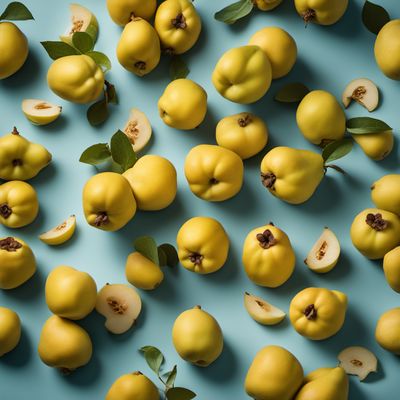
Ingredient
Other Pome fruits
The Versatile Pomaceous Delights
Other pome fruits, including quinces, medlars, and loquats, belong to the same family as apples and pears, known as the Rosaceae family. They possess unique flavors and textures, ranging from tart and astringent to sweet and juicy, making them a delightful addition to various culinary creations.
Origins and history
Quinces have a long history dating back to ancient Greece and Rome, where they were highly prized for their fragrance and culinary uses. Medlars were popular during the medieval period and were often consumed when overripe, known as bletting." Loquats have been cultivated in China for over a thousand years and are considered a symbol of fertility and abundance."
Nutritional information
Other pome fruits are a good source of dietary fiber, vitamin C, and antioxidants. They also contain various minerals such as potassium and manganese. With their low calorie content, they can be enjoyed as part of a healthy diet.
Allergens
Individuals with known allergies to apples or pears may also be allergic to other pome fruits. It is advisable to exercise caution and seek medical advice if any adverse reactions occur.
How to select
When selecting other pome fruits, choose those that are firm, unblemished, and have a vibrant color. Avoid fruits that are overly soft, bruised, or have moldy spots. Additionally, consider the specific ripeness requirements of each fruit, as some may need to be ripened further at home.
Storage recommendations
To prolong the shelf life of other pome fruits, store them in the refrigerator in a perforated plastic bag or an airtight container. Consume them within a few days of purchase for the best flavor and texture. Quinces can be stored for longer periods in a cool, dark place.
How to produce
Quinces, medlars, and loquats can be grown in suitable climates with adequate sunlight and well-drained soil. They require regular watering and pruning to maintain their health and productivity. Amateur gardeners can start by obtaining young plants or seeds from nurseries or online suppliers.
Preparation tips
Other pome fruits can be used in a variety of culinary applications. Quinces are often cooked down into jams, jellies, or used in pies and tarts. Medlars are typically consumed when overripe, either raw or used in preserves and desserts. Loquats are enjoyed fresh as a snack, added to fruit salads, or used in desserts such as cakes and sorbets.
Culinary uses
Other pome fruits are commonly used in traditional European, Middle Eastern, and Asian cuisines. They are often incorporated into jams, jellies, compotes, and desserts, adding unique flavors and textures to the dishes.
Availability
Quinces are commonly cultivated in Europe, particularly in Mediterranean countries such as Spain, Italy, and Greece. Medlars are found in parts of Europe, the Middle East, and North Africa. Loquats are primarily grown in China, Japan, and other Asian countries.
More ingredients from this category

Pears and similar-
The Versatile Fruit: Pears and Their Kin

Apples and similar-
The Versatile Fruit: Apples and Their Kin

Quinces and similar-
The Golden Apple: Quinces and Their Kin

Loquats and similar-
The Golden Gems: Loquats and Similar Fruits

Medlars and similar-
Rediscovering Ancient Fruits: The Unique Charm of Medlars and Similar Fruits